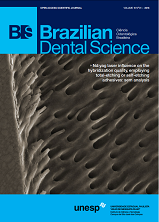Effect of the photoinitiator system on the properties of a dental material based on a hybrid polymer
DOI:
https://doi.org/10.14295/bds.2016.v19i1.1233Resumo
Objective: In this study, the effects of two different cure protocols upon the properties of composites using a hybrid-polymer as dental resin were evaluated. Material and Methods: Two distinct dental composites were prepared, one containing a mixture of TEGDMA/bis-GMA (50:50) and, another containing a mixture of TEGDMA/p-MEMO (50:50), [p-MEMO: oligomeric inorganic precursor]. Both composites were polymerized with lucirin and canphorquinone as photoinitiators. The composites were made with a 70 % wt of inorganic filler. Flexural strength was evaluated with a universal test machine and the degree of conversion was measured by infrared spectroscopy. A helium pycnometer was used to obtain polymer shrinkage data. Sorption tests were performed and SEM microscopy was used to show deleterious effects upon the resins’ surfaces. Results: The sample base on TEGDMA/p-MEMO polymerized with lucirin (L-T/p) showed the best values of the monitored properties. Conclusion: Lucirin is the most suitable photoinitiator for dental composites containing hybrid polymers.
Keywords
Dental resins; Flexural strength; Hybrid polymer; Photoinitiator system; Polymerization shrinkage.
Downloads
Downloads
Publicado
Como Citar
Edição
Seção
Licença
TRANSFERÊNCIA DE DIREITOS AUTORAIS E DECLARAÇÃO DE RESPONSABILIDADE
Toda a propriedade de direitos autorais do artigo "____________________________________________________________________" é transferido do autor(es) para a CIÊNCIA ODONTOLÓGICA BRASILEIRA, no caso do trabalho ser publicado. O artigo não foi publicado em outro lugar e não foi submetido simultaneamente para publicação em outra revista.
Vimos por meio deste, atestar que trabalho é original e não apresenta dados manipulados, fraude ou plágio. Fizemos contribuição científica significativa para o estudo e estamos cientes dos dados apresentados e de acordo com a versão final do artigo. Assumimos total responsabilidade pelos aspectos éticos do estudo.
Este texto deve ser impresso e assinado por todos os autores. A versão digitalizada deverá ser apresentada como arquivo suplementar durante o processo de submissão.




























